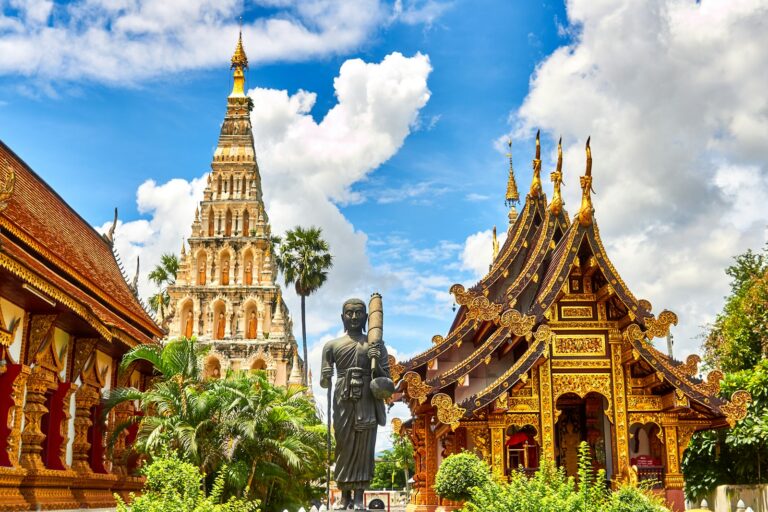Introduction
In the lush hills of northern Thailand, far from the sun-soaked beaches and bustling metropolises, lies a city rich in cultural contrast and artistic expression: Chiang Rai. While it may be best known for the ethereal White Temple (Wat Rong Khun), there’s another, darker marvel just as captivating—the Baan Dam Museum, also known as the Black House.
A visit to Chiang Rai isn’t complete without exploring this enigmatic art installation. Mysterious, provocative, and deeply philosophical, the Baan Dam Museum challenges visitors to reflect on life, death, and the complexity of Thai culture through a lens of dark artistry.
What is the Baan Dam Museum?
Created by the late Thai artist Thawan Duchanee, the Baan Dam Museum is not a traditional museum in the Western sense. Rather, it’s a sprawling collection of over 40 black-themed buildings and pavilions, each housing Duchanee’s personal artwork, sculptures, and bizarre collections.
Located just 10 km north of Chiang Rai city, Baan Dam is an immersive journey into the artist’s mind. The structures blend traditional Lanna-style architecture with haunting modern aesthetics. Black wood, animal skulls, crocodile skins, bones, and horns form the basis of its visual language, provoking both fascination and discomfort.
The Artistic Philosophy
Thawan Duchanee’s vision for Baan Dam was deeply rooted in Buddhist philosophy, though interpreted in a radical and deeply symbolic way. The juxtaposition of beauty and decay, light and shadow, is meant to evoke the samsara cycle—birth, death, and rebirth.
Visitors often interpret the Black House as a counterpoint to the White Temple, created by Duchanee’s contemporary, Chalermchai Kositpipat. While the White Temple represents the purity and aspirations of heaven, Baan Dam delves into the raw, primal instincts of human nature.
What to Expect During Your Visit
1. Unique Architecture:
Wander through an eclectic collection of wooden halls, igloo-shaped buildings, and art studios. Each structure holds a different exhibit or artistic surprise.
2. Intriguing Artifacts:
From buffalo horns to snakeskin-covered chairs, the museum showcases a wide array of natural materials reimagined as art. Furniture carved with mythical creatures, tribal weaponry, and surrealist paintings abound.
3. Tranquil Gardens:
Despite the heavy themes, the grounds are peaceful and beautifully landscaped, offering spots to sit and reflect.
4. Unfiltered Imagination:
Some installations are intentionally provocative and may not be suitable for young children. Be prepared to confront themes of mortality and power.
Practical Information
- Location: Moo 13, Tambon Nang Lae, Amphoe Mueang, Chiang Rai
- Opening Hours: 9:00 AM to 5:00 PM (Closed on public holidays)
- Entry Fee: Approx. 80 THB (subject to change)
- Dress Code: No strict dress code, but respectful attire is encouraged
- Photography: Allowed, but some areas may be restricted
How to Get There
- By Taxi/Grab: Easy and affordable from Chiang Rai city centre (approx. 15–20 minutes).
- By Tour: Often included in full-day Chiang Rai cultural tours.
- By Scooter: Rent a motorbike for flexibility and explore nearby attractions like the Mae Fah Luang Art & Cultural Park or Wat Huay Pla Kang.
Nearby Attractions
- Wat Rong Khun (White Temple): A dazzling white temple just a short drive away.
- Blue Temple (Wat Rong Suea Ten): A stunning modern temple with deep sapphire hues.
- Chiang Rai Night Bazaar: Great for local food, handicrafts, and a relaxed evening vibe.
Final Thoughts
The Baan Dam Museum is not just a place to see art—it’s a place to feel it, question it, and perhaps even be changed by it. Thawan Duchanee’s legacy lives on in every carved door, every skull-adorned table, and every shadowed corner of this surreal estate.
For those looking to explore the deeper, more introspective side of Thailand’s cultural tapestry, Baan Dam is an unmissable stop. Let it challenge your senses and expand your perspective—because in the dark, sometimes we find unexpected light.
